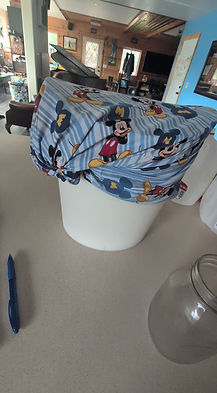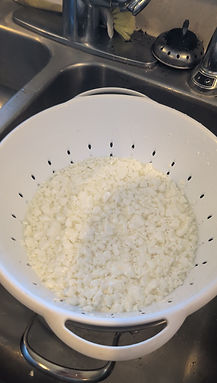LABs
Lactobacillus
This recipe is inspired by the one published by The Unconventional Farmer - thanks for the well-worded process! It stacks up perfectly with one of my favorite books: The Regenerative Grower's Guide to Garden Amendments. Share your experience below in the comments and feel free to reverberate this knowledge far and wide!
There are a ton of uses for LABs, but in my world it is mostly used for plant health. I look at it like I look at yogurt or booch or other ferments we eat - it strengthens the immune system and increases the health of the microbiome. As above, so below! LABs improves soil health and your plants' ability to withstand all types of problems, including mold and pest pressure.
How to Make Lactic Acid Bacteria (LAB)
Because if I can do it, so can YOU
*if you are on a mobile device, scroll to the bottom for videos*
Step 1: Make a Rice Wash
Fill a container halfway with rice wash—this is the water left after rinsing uncooked rice. Swirl rice in warm water, then drain the cloudy liquid. That’s your base.
No rice? No problem. Use other complex carbs like barley, wheat, or quinoa. Just avoid simple sugars (like honey, syrup, molasses, or white sugar).
Cover the container loosely and let it sit for a few days to a week. Warmer temps = faster fermentation.
You'll know it's ready when:
-
It smells a bit tangy
-
You see three layers:
-
Top: floating starches or molds
-
Middle: LAB-rich liquid (this is what you want)
-
Bottom: sediment and starch byproducts
-
Extract the middle layer by pouring off carefully.
Step 2: Grow the LAB with Milk
In a larger container, mix your extracted LAB with 10 parts milk (e.g., 1 cup LAB + 10 cups milk).
Best milk? Unpasteurized is ideal, but any milk—even powdered—will work.
Cover with a cloth to keep the bad stuff out while still allowing it to breathe.
After about a week:
-
Curds will form on top
-
Yellow whey underneath = your LAB-rich serum
Skim or strain off the curds and keep the whey. Save those curds—they’re still loaded with nutrients and microbes. Can feed to your animals... or even eat yourself! Do NOT eat if using old milk.
To preserve at room temp, add equal parts sugar or molasses (1L LAB = 1kg sugar or 1L molasses). Or store in the fridge.
Sample Recipe
1L rice wash + 10L milk
→ remove curds (~1L)
= ~10L LAB-rich whey
10kg sugar or 10L molasses
→ Yields ~20L of stabilized LAB serum
What is the active lacto strain in LABs?
In most DIY LAB preparations, the dominant strain that naturally proliferates is:
Lactobacillus casei
But it’s not alone—depending on the environment and source materials (like rice wash and milk), other strains may also be present, such as:
-
Lactobacillus plantarum
-
Lactobacillus brevis
-
Lactobacillus delbrueckii
-
Lactobacillus acidophilus
These are all common in natural fermentation environments. What makes L. casei so effective is its ability to thrive in a wide pH range and rapidly break down organic matter, converting it into simpler compounds plants and microbes can use.
In short: LABs are a diverse mix, but Lactobacillus casei tends to be the star of the show in traditional plant ferments.
🌱 Utilizing LABs for Plants!
Plant Growth & Health
Dilution: 1 teaspoon per Liter or 1 Tablespoon per Gallon
✅ Growth & Nutrient Uptake
-
Use as a foliar spray or soil drench
-
Works great with compost teas or organic fertilizers
-
Probiotic (active microbes): LAB is full of beneficial bacteria that can suppress harmful pathogens, speed up decomposition, and help plants absorb nutrients more efficiently. It literally outcompetes the “bad guys” in the soil or on plant surfaces.
-
Prebiotic (food for microbes): While LAB itself is not a prebiotic, when you combine it with something sugary (like in FPJ or compost teas), that sugar acts as the prebiotic fuel to feed both the LAB and other helpful microbes.
So in a way, when you're using LAB in ferments or teas, you’re usually giving your soil both the probiotic culture and its prebiotic buffet. Pretty rad synergy.
✅ Disease Resistance
-
Boosts plant immunity
-
Crowds out harmful microbes
✅ Fertilizer Booster
-
Add 1–2 tbsp per gallon of water-nutrient solution
-
Helps convert organic nutrients into plant-usable forms
✅ Compost Accelerator
-
Spray 2 tbsp LAB per 1L water on compost piles
-
Speeds up breakdown and improves compost quality
✅ Aquaculture
-
Use ~1L LAB per 700m³ of pond or tank water
-
Reduces waste, boosts fish growth, increases capacity
🐄 Animals & Odor Control
✅ Digestive & Growth Aid
-
Mix 2 tbsp LAB per 1L water, then add to drinking water at 2 tbsp/L
-
Soak feed in LAB water to pre-digest and boost nutrient uptake
✅ Humans Too
-
After a heavy meal: 1–2 tbsp LAB in water = better digestion, more energy
✅ Bedding Treatment
-
Spray 2 tbsp LAB per 1L water onto bedding
-
Reduces odor, extends bedding life
-
Adjust for humidity and smell level
✅ Odor Control
-
Add to water dishes or spray directly
-
Use indoors (litter boxes, shoes, etc.) or outdoors (barns, pens, etc.)
🧼 Around the House
✅ Drains & Septic
-
Pour a few tbsp to 1L into drains overnight to unclog
-
Add to toilet every few months to maintain septic systems
✅ Houseplants
-
Mix 2–3 tbsp LAB per 1L water for routine watering
-
Supports root health and microbial soil life












